
TO THE INSTALLER: PLEASE LEAVE THIS
INSTRUCTION BOOK WITH THE UNIT.
TO THE CONSUMER: PLEASE READ AND
KEEP THIS BOOK FOR FUTURE REFERENCE.
GAS RANGES
MODELS SF3000SY/EY SF304BSA SF302BSA/BEA 8SF302PSY

TO THE INSTALLER: PLEASE LEAVE THIS
INSTRUCTION BOOK WITH THE UNIT.
TO THE CONSUMER: PLEASE READ AND
KEEP THIS BOOK FOR FUTURE REFERENCE.
GAS RANGES
MODELS SF3000SY/EY SF304BSA SF302BSA/BEA 8SF302PSY

A Note To You
Thank you for buying a Whirlpool@ appliance.
Because your life is getting busier and more complicated, Whirlpool ranges are easy to use, save time, and help you manage your home better. To ensure that you will enjoy years of
Your safety is important to us.
This guide contains safety symbols and statements. Please pay special attention to these symbols and follow any instructions given. Here is a brief explanation of the use of each symbol.
This symbol will help alert you to such dangers as personal injury, burns, fire and electrical shock.
This symbol will help you avoid actions which could cause product damage (scratches, dents, etc.) and damage to your personal property.
.INSTALL
\.:
DEVICES PACKED
WITH RANGE.
*SEE INSTALLATION
INSTRUCTIONS.
@
For more information, see the
Our Consumer Assistance Center number,
If you ever have a question concerning your appliance???s operation, or if you need service, first see ???IfYou Need Assistance Or Service??? on page 25. If you need further help, feel free to call our Consumer Assistance Center or an authorized Whirlpool service company. When calling, you will need to know your appliance???s complete model number and serial number. You can find this information on the model and serial number plate (see diagram on page 6). For your convenience, we have included a handy place below for you to record these numbers, the purchase date from the sales slip and your dealer???s name and telephone number. Keep this book and the sales slip together in a safe place for future reference.
2
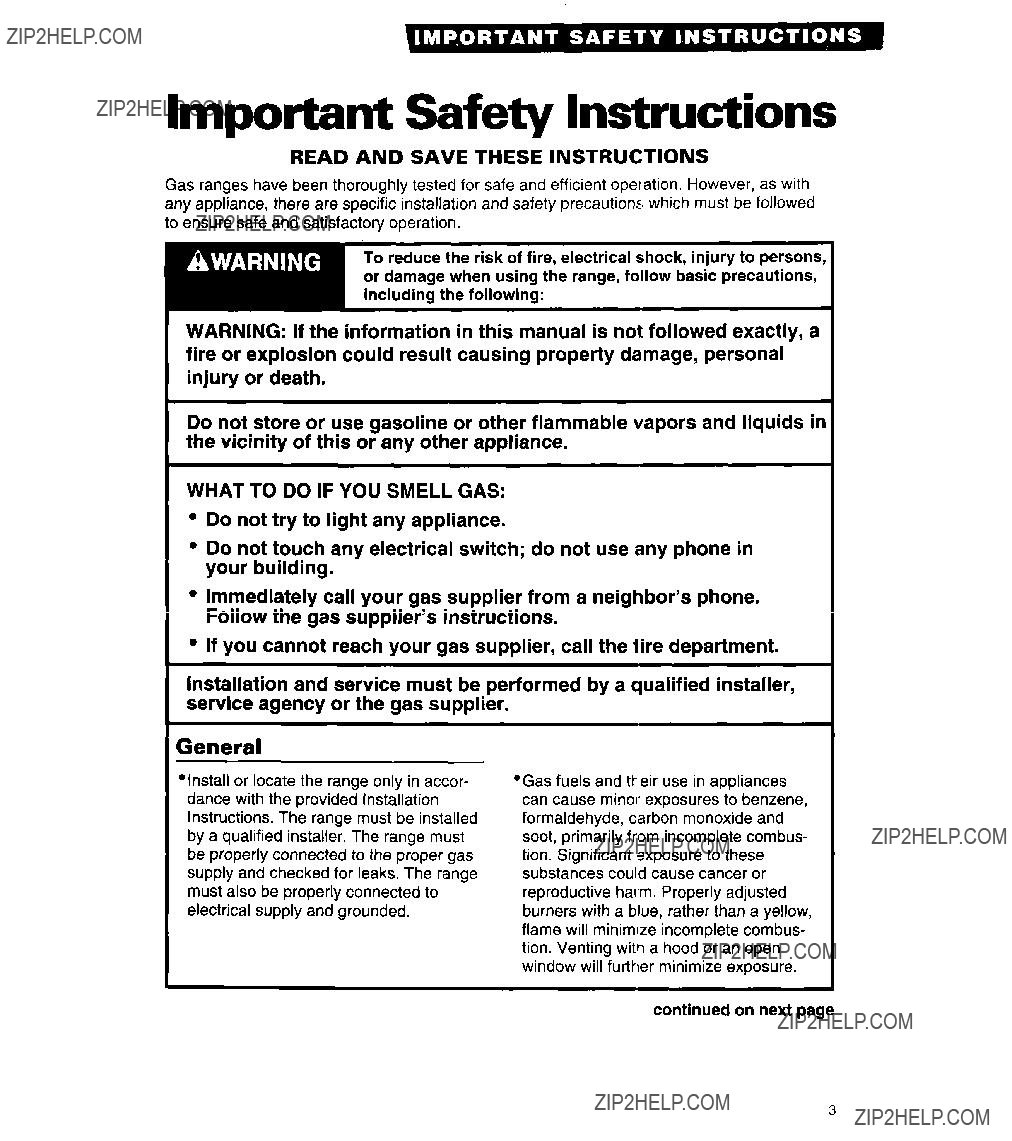
Important Safety Instructions
READ AND SAVE THESE INSTRUCTIONS
Gas ranges have been thoroughly tested for safe and efficient operation. However, as with any appliance, there are specific installation and safety precautions which must be followed to ensure safe and satisfactory operation.
To reduce the risk of fire, electrical shock, injury to persons, or damage when using the range, follow basic precautions, including the following:
WARNING: If the information in this manual is not followed exactly, a fire or explosion could result causing property damage, personal
injury or death.
Do not store or use gasoline or other flammable vapors and liquids in the vicinity of this or any other appliance.
WHAT TO DO IF YOU SMELL GAS:
l
l
Do not try to light any appliance.
Do not touch any electrical switch; do not use any phone in your building.
l Immediately call your gas supplier from a neighbor???s phone. Follow the gas supplier???s instructions.
l If you cannot reach your gas supplier, call the fire department.
Installation and service must be performed by a qualified installer, service agency or the gas supplier.
General
.Install or locate the range only in accor- dance with the provided Installation Instructions. The range must be installed by a qualified installer. The range must be properly connected to the proper gas supply and checked for leaks. The range must also be properly connected to electrical supply and grounded.
*Gas fuels and
continued on next page
3

1Do not store things children might
want above the range. Children could be burned or injured while climbing on it. 1Do not leave children alone or unat- tended in area where the range is in use. They should never be allowed to sit or stand on any part of the range. They could be burned or injured.
1Do not operate the range if it is damaged or not working properly.
t Do not use the range for warming
or heating the room. Persons could be burned or injured, or a fire could start.
I Do not attempt to light the oven burner on electric ignition models during a power failure. Personal injury could result. Reset oven controls to the off position in the event of a power failure.
BUse the range only for its intended use as described in this manual.
6Do not touch surface burners, areas near surface burners or interior surfaces of oven. Areas near surface burners and interior surfaces of an oven become hot enough to cause burns. During and after use, do not touch, or let clothing or other flammable materials contact surface burners, areas near surface burners or interior surfaces of oven until they have had sufficient time to cool. Other surfaces of the range, such as the oven vent opening, the surface near the vent opening, the cooktop, and the oven door, could also become hot enough to cause burns.
???\
6%
l Do not wear loose or hanging garments when using the range. They could ignite if they touch an open flame and you could be burned.
l Use only dry potholders. Moist or damp potholders on hot surfaces could result in burns from steam. Do not let potholder touch an open flame. Do not use a towel or bulky cloth for a potholder. It could catch on fire.
l Keep range vents unobstructed.
l Do not heat unopened containers. They could explode. The hot contents could cause burns and container particles could cause injury.
l Do not store flammable materials on or near the range. The fumes could create an explosion and/or fire hazard.
l Do not use the oven for storage.
l Do not use aluminum foil to line area around surface burners, oven bottom, or any other part of the range. Use aluminum foil only as recommended in this manual.
l Never use a match or other flame to look for a gas leak. Explosion and injury could result.
l Know where your main gas shutoff valve is located.
When using the cooktop
l Make sure the utensils you use are large enough to contain food and avoid boilovers and spillovers. Heavy splatterin! or spillovers left on a range could ignite and burn you. Pan size is especially important in deep fat frying.
4
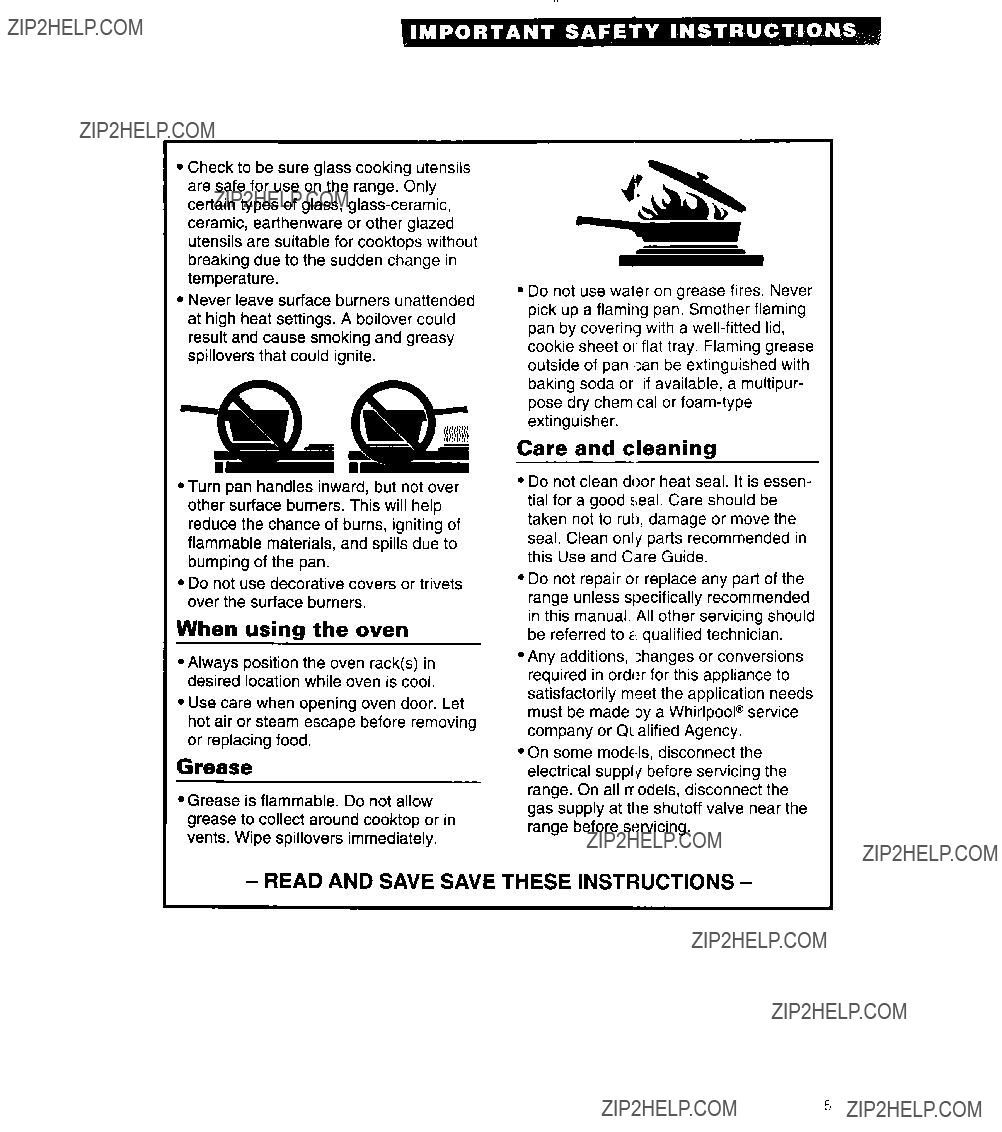
l Check to be sure glass cooking utensils are safe for use on the range. Only certain types of glass,
l Never leave surface burners unattended at high heat settings. A boilover could result and cause smoking and greasy spillovers that could ignite.
l Turn pan handles inward, but not over other surface burners. This will help reduce the chance of burns, igniting of flammable materials, and spills due to bumping of the pan.
l Do not use decorative covers or trivets over the surface burners.
When using the oven
l Always position the oven rack(s) in desired location while oven is cool.
l Use care when opening oven door. Let hot air or steam escape before removing or replacing food.
Grease
@Grease is flammable. Do not allow grease to collect around cooktop or in vents. Wipe spillovers immediately.
l Do not use water on grease fires. Never pick up a flaming pan. Smother flaming pan by covering with a
Care and cleaning
l Do not clean door heat seal. It is essen- tial for a good :,eal. Care should be taken not to rub, damage or move the seal. Clean only parts recommended in this Use and Care Guide.
l Do not repair or replace any
*Any additions, #:hanges or conversions required in order for this appliance to satisfactorily meet the application needs must be made my a Whirlpool@ service company or QL alified Agency.
???On some mode Is, disconnect the electrical supply before servicing the range. On all rr???odels, disconnect the gas supply at the shutoff valve near the range before servicing.
- READ AND SAVE SAVE THESE INSTRUCTIONS -
5

Parts And Features
This section contains captioned illustrations of your range. Use them to become familiar with the location and appearance of all parts and features.
Backguard
model)
Surface burners and grates
Control panel
Model and serial number plate
(under cooktop)
_ Oven burner (not shown)
Broiler drawer
Control panel
6
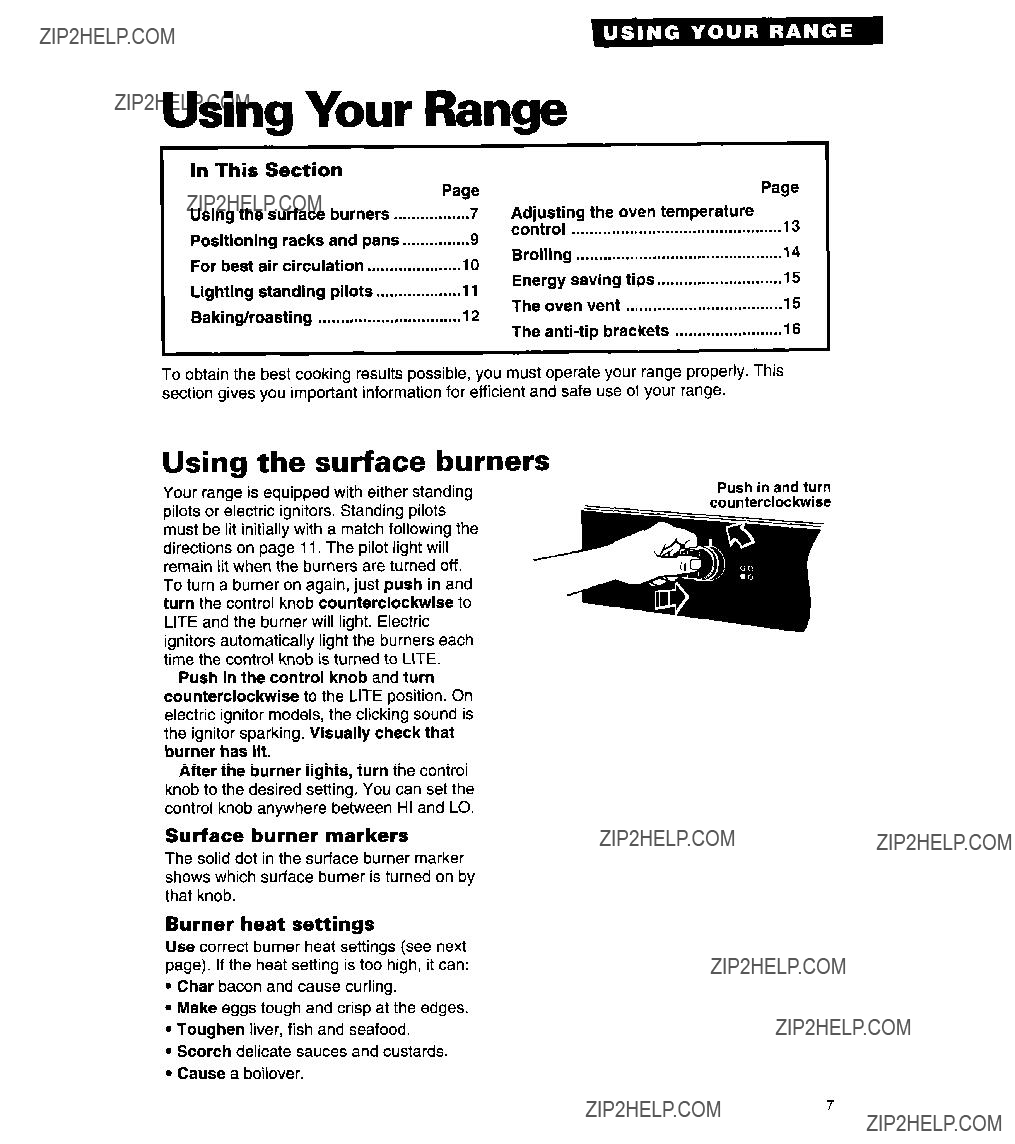
Using Your Range
To obtain the best cooking results possible, you must operate your range properly. This section gives you important information for efficient and safe use 01 your range.
After the burner lights, turn the control knob to the desired setting. You can set the control knob anywhere between HI and LO.
Surface burner markers
The solid dot in the surface burner marker shows which surface burner is turned on by that knob.
Burner heat settings
Use correct burner heat settings (see next page). If the heat setting is too high, it can: l Char bacon and cause curling.
l Make eggs tough and crisp at the edges. l Toughen liver, fish and seafood.
l Scorch delicate sauces and custards. l Cause a boilover.
7

Until you get used to the settings, use the following as a guide. For best results, start cooking at the high setting; then turn the control knob down to continue cooking.
In case of a prolonged power failure
Surface burners with electric ignitors can be
manually lighted. Hold a lit match near a
. . . . ..
ourner ana slowly turn tne control knob on until the burner lights. After the burner lights, turn the control knob to the desired setting. Power failures will not affect stand- ing pilots. Do not attempt to operate an electric ignition oven during a power failure.
Burn, Fire and Explosion Hazard
. Burner flame should not extend
beyond the edge of the cooking utensil. The flame could burn you
and cause poor cooking results.
. Be sure all control knobs are turned to OFF when you are not cooking. Someone could be burned or a fire could start if a burner is accidentally left ON.
. If the flame should go out while cook- ing, or if there is a strong gas odor, turn the burners OFF. Wait five min- utes for the gas odor to disappear before relighting burner. If gas odor is still present, see safety note on page 3. Failure to follow these precautions
could result in explosion or fire.
Product Damage Hazard
Do not leave an empty utensil, or one which has boiled dry, on a hot surface burner.
The utensil could overheat and could damage the utensil or cooking product.
Cookware tips
No one brand of cookware is best for all people. Knowing something about pan materials and construction will help you select the correct cookware for your needs.
. NOTE: For best results and greater fuel efficiency, use only
. Choose medium to heavy gauge (thick- ness) pans that are fairly lightweight.
*The pan material (metal or glass) affects how fast heat transfers from the surface burners through the pan material and how evenly heat spreads over the pan bottom. Choose pans that provide the best cooking results.
. Handles should be made of a sturdy, heat- resistant material and be securely attached to the pan.

l
l
l
Pans should be easy to clean. Check to be sure there are no crevices, rough edges or areas where food might collect.
Be sure pans do not tip, whether they are full or empty.
Use cookware only as it was intended to be used. Follow pan instructions. This is very important for glass cookware because some should be used only in the oven. Other pans are marked as flameware and may be used on the surface burners.
Home canning information
The larger diameter of most
To protect your range:
l For best results, use a canner which can be centered over the surface burner.
l Do not place canner on two surface burners at the same time. Too much heat will build up and will damage the cooktop.
l Start with hot water. This reduces the time the control IS set on high. Reduce heat setting to lowest position needed to keep water boiling.
l Refer to your canner manual for specific instructions.
Positioning racks and
For baking/roasting with one rack, place the rack so the top of the food will be centered in the oven.
Rack placement for specific foods:
Angel and bundt cakes, 2nd rack guide most quick breads, from bottom yeast breads, casse-
roles, meats
When baking on two racks, arrange racks on first and third rack guides from bottom.
pans
Personal Injury Hazard
*Always position oven rack(s) in desired location before turning oven on. Be sure the rack(s) is level.
l If rack(s) must be moved while oven is hot, use potholders or oven mitts to protect hands.
l Do not place iiems on the open oven door.
l Be careful when installing and removing large food items from extra roasting rack position. Food will be close to hot surfaces, including oven bottom and sides.
Failure to follow the above precautions could result in personal injury.
continued on next page g

Extra oven rack position (roasting rack)
For best air circulation
Hot air must circulate around the pans in the oven for even heat to reach all parts of the oven. This results in better baking.
l Place the pans so that one is not directly over the other.
l For best results, allow
between pans and oven walls. There must be a minimum space of 1 inch (2.5 cm).
l Use only one cookie sheet in the oven at one time.
Use the following as a guide to determine where to place the pans:
One pan
Place in the center of the oven rack.
Two pans
Place in opposite corners of the oven rack.
Three or four pans
Place in opposite corners on each oven rack. Stagger pans so no pan is directly over another.
\
Extra oven rack
position
!O
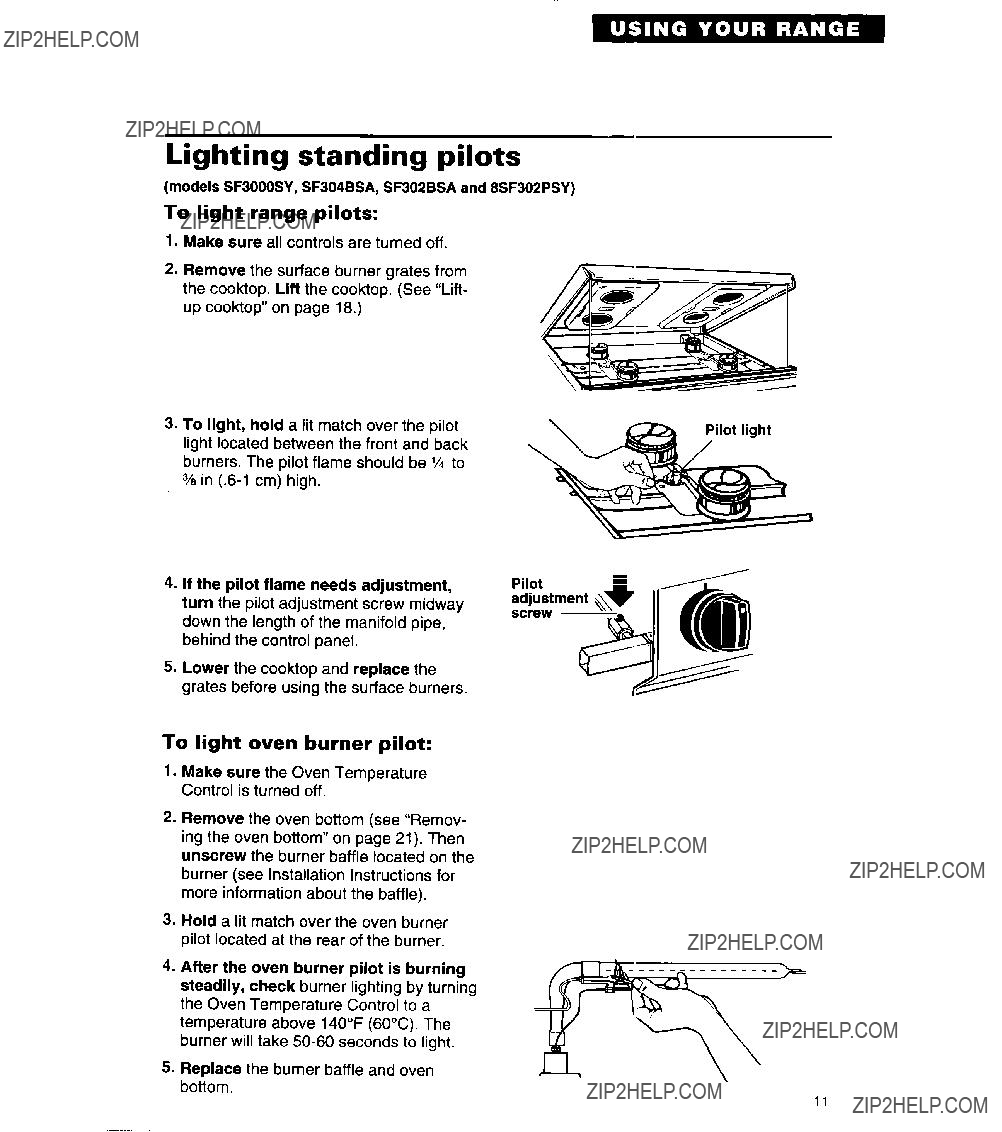
Lighting standing pilots
(models SF3OOOSY, SF304BSA, SF302BSA and BSF302PSY)
To light range pilots:
1.Make sure all controls are turned off.
2.Remove the surface burner grates from the cooktop. Lift the cooktop. (See ???Lift- up cooktop??? on page 16.)
3.To light, hold a lit match over the pilot light located between the front and back burners. The pilot flame should be l/4 to % in
4.If the pilot flame needs adjustment, turn the pilot adjustment screw midway down the length of the manifold pipe, behind the control panel.
5.Lower the cooktop and replace the grates before using the surface burners.
To light oven burner pilot:
1.Make sure the Oven Temperature Control is turned off.
2.Remove the oven bottom (see ???Remov- ing the oven bottom??? on page 21). Then unscrew the burner baffle located on the burner (see Installation Instructions for more information about the baffle).
3.Hold a lit match over the oven burner pilot located at the rear of the burner.
4.After the oven burner pilot is burning steadily, check burner lighting by turning the Oven Temperature Control to a temperature above 140??F (60??C). The burner will take
5.Replace the burner baffle and oven bottom.
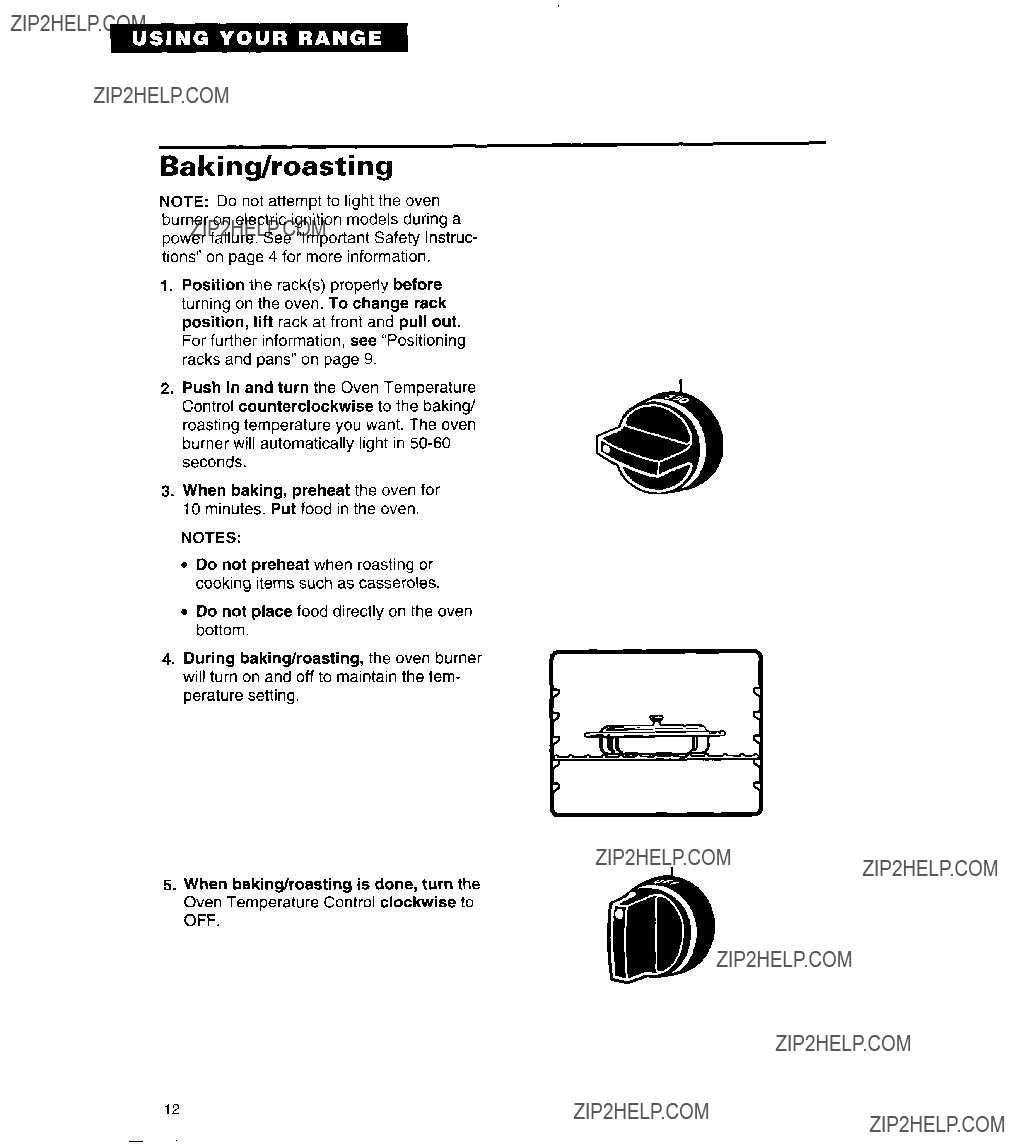
Baking/roasting
NOTE: Do not attempt to light the oven burner on electric ignition models during a power failure. See ???Important Safety Instruc- tions??? on page 4 for more information.
1.Position the rack(s) properly before turning on the oven. To change rack
position, lift rack at front and pull out. For further information, see ???Positioning racks and pans??? on page 9.
2.Push in and turn the Oven Temperature Control counterclockwise to the baking/ roasting temperature you want. The oven burner will automatically light in
3.When baking, preheat the oven for 10 minutes. Put food in the oven.
NOTES:
l Do not preheat when roasting or cooking items such as casseroles.
lDo not place food directly on the oven bottom.
4.During baking/roasting, the oven burner will turn on and off to maintain the tem- perature setting.
5.When baking/roasting is done, turn the Oven Temperature Control clockwise to OFF.
12

Adjusting the oven temperature
Oven temperature controls will gradually shift after years of use. So, even though your new oven is properly adjusted to provide accurate temperatures, it may cook faster or slower than your old oven.
If, after using the oven for a period of time, you are not satisfied with the temperature settings, you can adjust them by following these steps:
1.Make sure the Oven Temperature Control Knob is turned to the off position. Pull knob straight off and flip it over.
2.Loosen the locking screws inside the control knob. Note the position of the notches.
3.To lower the temperature, hold knob handle firmly and move the tooth a notch clockwise. Each notch equals about 20??F (11??C).
5.Tighten the locking screws and replace the control knob.
control
To lower
Tooth
13

Broiling
The broiler drawer is located below the oven door. Always broil with the oven door closed.
1.Pull the broiler drawer open and tilt the door panel down.
3.Before the broiler is turned on, place food on broiler pan and position the broiler pan at one of the three levels.
4.Close broiler drawer.
5.Push in and turn the Oven Temperature Control counterclockwise to BROIL. The broiler will automatically light in
5.When broiling is done, turn the Oven Temperature Control clockwise to OFF.
NOTE: Do not preheat the broiler before using. Completely close the broiler drawer during broiling.
14

Energy saving tips
Although the energy used for cooking is usually a very small percentage of the total energy used in the home, cooking energy can be used efficiently. Here are some tips to help you save energy when using your cooking product:
l Use pans with flat bottoms, straight sides and
l Cook with a minimum of liquid or fat to help shorten cooking time.
l Preheat pans only when recommended and for the shortest time possible.
l
l Use the more efficient surface burners instead of the oven when possible.
The oven vent
Hot air and moisture escape from the oven through a vent located at rear of cooktop. The vent is needed for air circulation. Do not block the vent. Poor baking/roasting will result.
NOTE: Never store plastics, paper or other items that could melt or burn near the oven vent, or any of the surface burners.
Burn Hazard
When the oven is ON, pans and pan handles left near the oven vent could become hot enough to burn the user and to melt plastics. Use potholders to move pans.
l
l
l
l
l
l
Turn on the surface burner only after placing filled pan on the burner grate. ???Oven peeking??? may cause heat loss, longer cooking times and unsatisfactory baking results. Rely on your timer to keep track of the cooking time.
Bake cakes, pies or cookies when oven is warm. Best time to bake is right after a meal has been cooked in oven.
Preheat the oven no longer than necessary.
Plan your meals for the most efficient use of the range. When using the oven to cook one food, try to cook the rest of the meal in it also.
Do not preheat when broiling, roasting or cooking items such as casseroles.
15

The
The range will not tip during normal use. However, tipping can occur if you apply too much force or weight to the open door without the
Personal Injury Hazard
l
l
To reduce risk of range tipping over, secure range with properly installed
If range is moved for cleaning or service, check that
Failure to follow the above precautions could result in personal injury.
To verify the
l Grasp rear of range and carefully try to tilt forward. If
l See Installation Instructions for further details.
16

Caring For Your Range
Your range is designed for easy care. You can do most cleaning with items found around your home. Cleaning your range whenever spills or soiling occurs will help to keep it looking and operating like new.
Page
Removing the oven door .....V...........20
Removing the oven bottom .............21
Cleaning
Burn, Electrical Shock, Fire and
Explosion Hazard
l Make sure all controls are OFF and the range is cool before cleaning.
. Do not use oven cleaners, bleach or rust removers.
lDo not obstruct the flow of combustion and ventilation air.
l Keep appliance area clear and free of combustible materials, gasoline and other flammable vapors and liquids.
I Failure to follow these guidelines could result in burns, electrical shock, fire or explosion.
Surface burner grates
1.Make sure all surface burners are off and the surrounding parts are cool.
2.Lift off the surface burner grates.
3.Wash the grates with warm, soapy water or in a dishwasher. Use a nonabrasive, plastic scrubbing pad for
4.Replace burner grates.
17

1. Remove surface burner grates.
2.Lift front of cooktop at both front corners until the support rods lock into place.
Personal Injury Hazard
Be sure both support rods are fully extended and in the locked position.
Failure to do so could result in per- sonal injury from the cooktop acciden- tally falling.
Product Damage Hazard
Do not drop the cooktop. Damage could result to the porcelain and the cooktop frame.
3.Wipe with warm, soapy water. Use a soapy
NOTE: When cleaning under the cooktop on standing pilot models, be careful not to extinguish pilots.
4.To lower the cooktop, lift cooktop from both sides while pressing the support rods back to unlock them. Lower the cooktop into place. Replace surface burner grates.
18

Surface burners
1.Lift up the cooktop, following the instruc- tions above.
2.Before cleaning, remove screws that hold each of the burners in place. The screws prevent the burners from moving during shipment. Remove the shipping screws with a Phillips screwdriver, lift the burner up, tilt it to one side at the end closest to the ignitor and move it toward the back of the range. This separates the burner from the gas valve at the front of the range, so it can be easily removed.
3.Wipe off surface burners with warm, soapy water and a sponge after each use. To remove
4.If ports are clogged, clean with a straight pin. DO NOT enlarge or distort the ports. DO NOT use a toothpick to clean the ports.
5.Before putting the burners back, dry them thoroughly by setting them in a warm oven for 30 minutes.
6.Replace burners, making sure they are properly seated and level. Replace screws.
7.Occasionally check the burner flames for proper size and shape as shown. A good flame is blue in color. If flames lift off ports, are yellow, or are noisy when
turned off, you may need to clean the burners (see above), or call a qualified technician for adjustment.
Typical surface burner flame at the highest setting
19
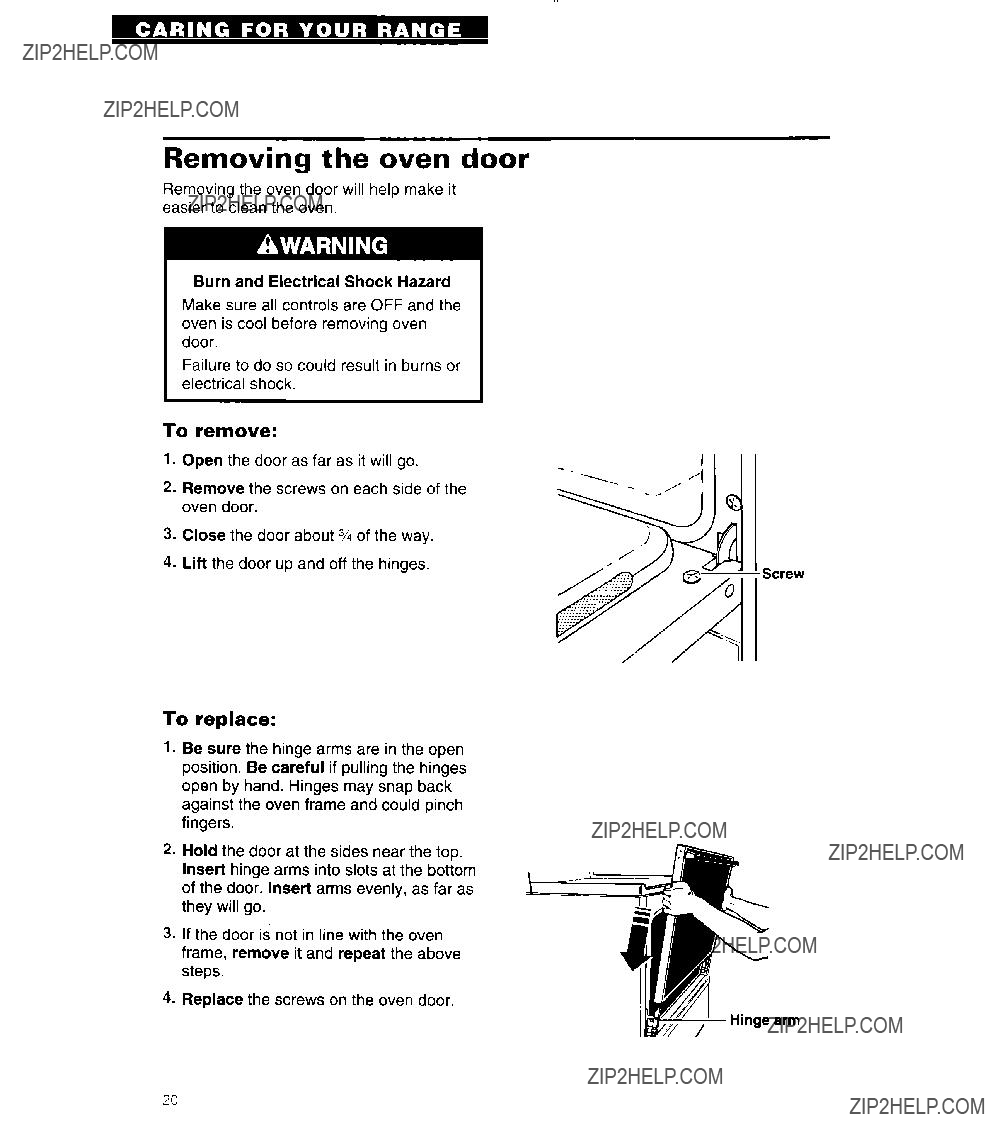
Removing the oven door
Removing the oven door will help make it easier to clean the oven.
Burn and Electrical Shock Hazard
Make sure all controls are OFF and the oven is cool before removing oven door.
Failure to do so could result in burns or electrical shock.
To remove:
1.Open the door as far as it will go.
2.Remove the screws on each side of the oven door.
3.Close the door about % of the way.
4.Lift the door up and off the hinges.
To replace:
1.Be sure the hinge arms are in the open position. Be careful if pulling the hinges open by hand. Hinges may snap back against the oven frame and could pinch fingers.
2.Hold the door at the sides near the top. Insert hinge arms into slots at the bottom of the door. Insert arms evenly, as far as they will go.
3.If the door is not in line with the oven frame, remove it and repeat the above steps.
4.Replace the screws on the oven door.
20

Removing the oven bottom
The panel in the oven bottom can be removed for cleaning or to light the burner pilot.
Burn Hazard
Make sure all parts are cool before removing.
Failure to do so could result in burns.
To remove:
1.Remove oven racks.
2.Remove the two
3.Place fingers in slots in bottom panel and lift rear of panel up and back until lip at the front of panel is clear of front frame of oven cavity.
4.Lift bottom up and out.
To replace:
1. Place oven bottom panel in oven with the back raised about 6 inches or until you can insert the
2. Push back of oven bottom panel down fully into place on metal flanges on rear
wall and insert the
21

Control knobs
Control panel
Exterior surfaces (other than control panel)
Sponge and warm, , soapy water
!Sponge and warm, soapy water
OR
Paper towel and spray glass cleaner
Sponge and warm, soapy water
l Turn knobs to OFF and pull straight away from control panel.
l Wash, rinse and dry thoroughly. Do not soak.
l Do not use steel wool or abrasive cleans- ers. They may damage the finish of the knobs.
l Replace knobs. Make sure all knobs point to OFF.
l Wash, rinse and dry thoroughly.
l Do not use steel wool or abrasive cleans- ers. They may damage the finish.
l Do not spray cleaner directly on panel. Apply cleaner to paper towel.
l Wash, rinse and dry thoroughly.
l Use nonabrasive, plastic scrubbing pad on heavily soiled areas.
l Do not use abrasive or harsh cleansers. They may damage the finish.
NOTE: Do not allow foods containing acids (such as vinegar, tomato or lemon juice) to remain on surface. Acids may remove the glossy finish. Also wipe up milk or egg spills when cooktop is cool.
Surface burner grates
Warm, soapy water and l In dishwasher, wash with other cooking
22

PART
Surface burners
Broiler drawer, pan and grid (clean after each ise)
Oven door glass (Models SF304BSA and SF302BSA/BEA)
WHAT TO USE
Sponge and warm, soapy water
Warm, soapy water and a nonabrasive, plastic scrubbing pad
OR
Vinegar and water solution
Paper towel and spray glass cleaner
OR
Warm, soapy water and a nonabrasive, plastic scrubbing pad
l Lift up the cooktop. (See page 18.)
l Wipe off spills immediately after burner has cooled.
For
l Remove burner from manifold with Phillips screwdriver.
l Wash with warm, soapy water and a plastic scrubbing pad or soak in vinegar and water solution.
l Rinse and dry well.
lIf ports are clogged, clean with a straight pin. Do not enlarge or distort ports. Do not use a wooden toothpick.
l Do not clean surface burner in dish- washer.
l Clean after each use.
l Wash, rinse and dry thoroughly.
l After broiler is cool, wipe interior with warm, damp sponge. For heavily
soiled areas, use a soapy
l Wash, rinse and dry thoroughly.
l Make sure oven is cool.
l Follow directions provided with the cleaner.
l Wash, rinse and dry thoroughly.
continued on next page
23
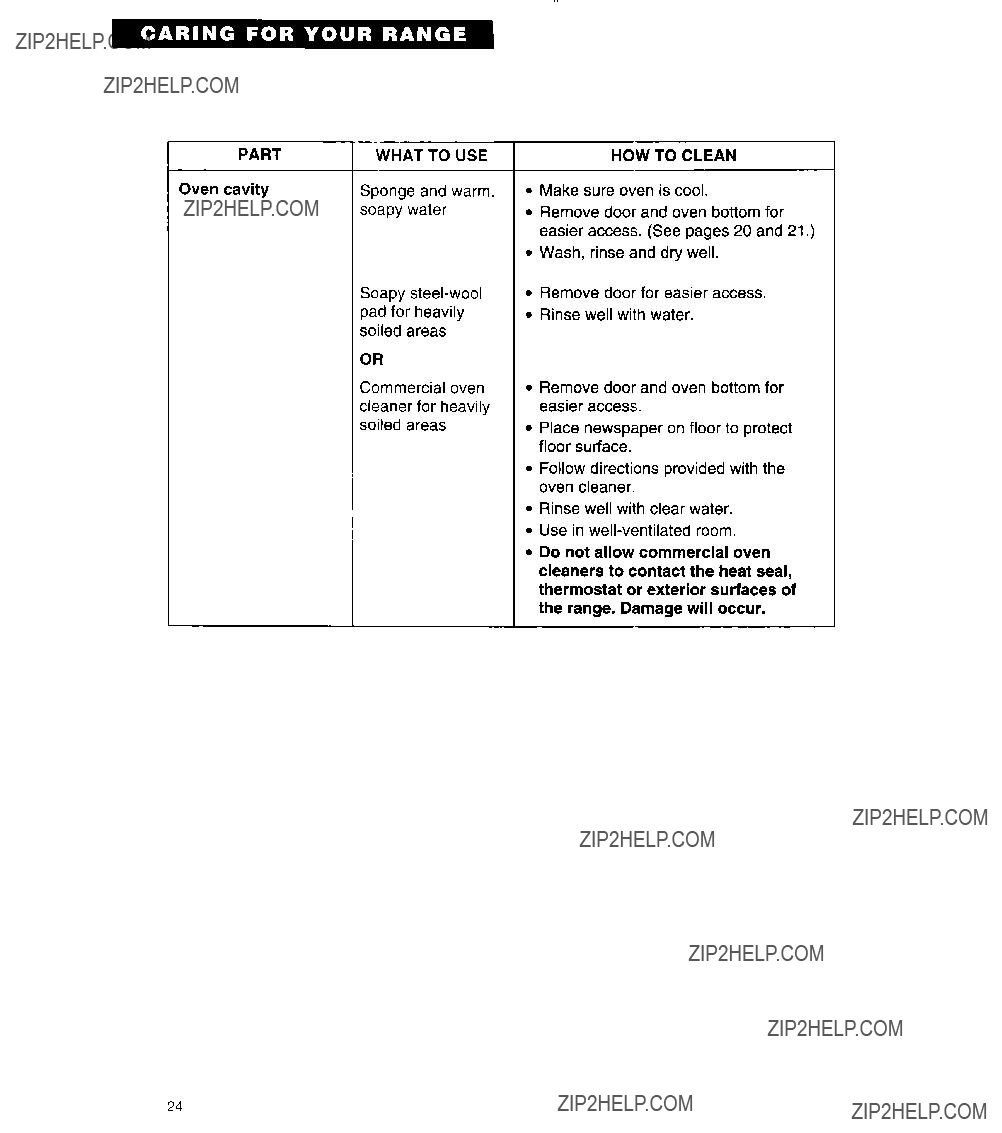
PART
Oven cavity
1 WHAT TO USE
Sponge and warm, soapy water
HOW TO CLEAN
rl Make sure oven is cool.
l Remove door and oven bottom for easier access. (See pages 20 and 21.)
l Wash, rinse and dry well.
Soapy
OR
Commercial oven cleaner for heavily soiled areas
l
l
l
l
l
l
l
l
Remove door for easier access. Rinse well with water.
Remove door and oven bottom for easier access.
Place newspaper on floor to protect floor surface.
Follow directions provided with the oven cleaner.
Rinse well with clear water. Use in
Do not allow commercial oven cleaners to contact the heat seal, thermostat or exterior surfaces of the range. Damage will occur.
24

If You Need Assistance
Or Service
This section is designed to help you save the cost of a service call.
1. Before calling for assistance ...
Performance problems often result from little things you can find and fix without tools of any kind. Please check the chart below for problems you can fix. It could save you the cost of a service call.
PROBLEM
Nothing will operate
The oven will not operate
Burner fails to light
POSSIBLE CAUSE
The power cord is not plugged into a live circuit with proper voltage.
Range is not properly con- netted to gas supply.
A household fuse has blown or a circuit breaker has tripped.
Controls are not set correctly.
The flow of combustion and/or ventilation air to the range is blocked.
The Oven Temperature Control is not turned to a temperature setting.
Pilot is extinguished on stand- ing pilot models.
The power cord is not plugged into a live circuit with proper voltage.
A household fuse has blown or a circuit breaker has tripped.
Burner ports are clogged.
Pilot is extinguished on stand- ing pilot models.
SOLUTION
Plug the power cord into a live circuit with proper voltage. (See Installation Instruc- tions.)
Contact an authorized Whirlpool@ service technician to reconnect range to gas supply. (See Installation Instructions.)
Replace household fuse or reset circuit breaker.
Reset controls, if needed.
Remove blockage to airflow to and around range.
Push in and turn the Oven Temperature Control to a temperature setting.
Light pilot. (See ???Lighting standing pilots??? on page 11.)
Plug the power cord into a live circuit with proper voltage. (See Installation Instruc- tions.)
Replace household fuse or reset circuit breaker. In case of prolonged power failure, manually light burners
(see page 8).
Clean with a straight pin (see pages 19 and 23).
Light pilot. (See ???Lighting standing pilots??? on page 11.)

PROBLEM
1 Burner flames are
1 uneven
1 Burner
I flames lift off 1 ports, are
i yellow, or / are noisy
j when turned j off
: Burner makes i popping noise
1 when on
I
/ Control
1 knob(s) will j not turn
ICooking results are not what you expected
L
POSSIBLE CAUSE
Burner ports are clogged.
Air/gas mixture is incorrect.
Burner is wet from washing.
You are not pushing in before turning.
The range is not level.
The oven temperature seems too low or too high.
The oven was not preheated as the recipe calls for.
The recipe has never been tested or is not from a reliable source.
The pans are not the type or size recommended in the recipe.
There is not proper air circula- tion around pan when baking.
Flame size does not fit the cooking utensil being used.
When broiling, you have not completely closed the broiler drawer.
SOLUTION
Clean with a straight pin (see pages 19 and 23). If this fails, call an authorized Whirlpool@ service technician for service.
Contact an authorized Whirlpool service technician to check air/gas mixture.
Let dry.
Push control knob(s) in before turning to a setting.
Level range. (See Installation Instructions.)
Adjust the oven temperature control. (See ???Adjusting the oven temperature control??? on page 13.)
Preheat oven if called for in recipe.
Use only tested recipes from a reliable source.
Refer to a reliable cookbook for recommended pan type and size.
Allow 1M to 2 inches
Adjust flame size to fit cooking utensil.
Completely close broiler drawer.
26

2. If you need assistance ...
Call Whirlpool Consumer Assistance Center telephone number. Dial
and talk with one of our trained consultants. The consultant can instruct you in how to obtain satisfactory operation from your appliance or, if service is necessary, recommend a qualified service company
in your area.
If you prefer, write to: Mr. William Clark
Consumer Assistance Representative Whirlpool Corporation
2000 North
Benton Harbor, Ml
Please include a daytime phone number in your correspondence.
Outside the U.S.A.:
Call an authorized Whirlpool service company.
technicians are trained to fulfill the product warranty and provide
Outside the U.S.A.:
Contact the distributor from whom you purchased your range or an authorized Whirlpool service company.
4.If you need FSP@ replace- ment parts ...
FSP is a registered trademark of Whirlpool Corporation for quality parts. Look for this symbol of quality whenever you need a replacement part for your Whirlpool@ appli- ance. FSP replacement parts will fit right and work right, because they are made to the same exacting specifications used to build every new Whirlpool appliance.
To locate FSP replacement parts in your area, refer to Step 3 above, call the Whirl- pool Consumer Assistance Center number in Step 2 or call an authorized Whirlpool service company.
5.If you are not satisfied with how the problem was
solved (for U.S.A. only) ...
*Contact the Major Appliance Consumer Action Panel (MACAP). MACAP is a group of independent consumer experts that voices consumer views at the highest levels of the major appliance industry.
*Contact MACAP only when the dealer, authorized servicer and Whirlpool have failed to resolve your problem.
Major Appliance Consumer Action Panel 20 North Wacker Drive
Chicago, IL 60606
l MACAP will in turn inform us of your action.
27 I
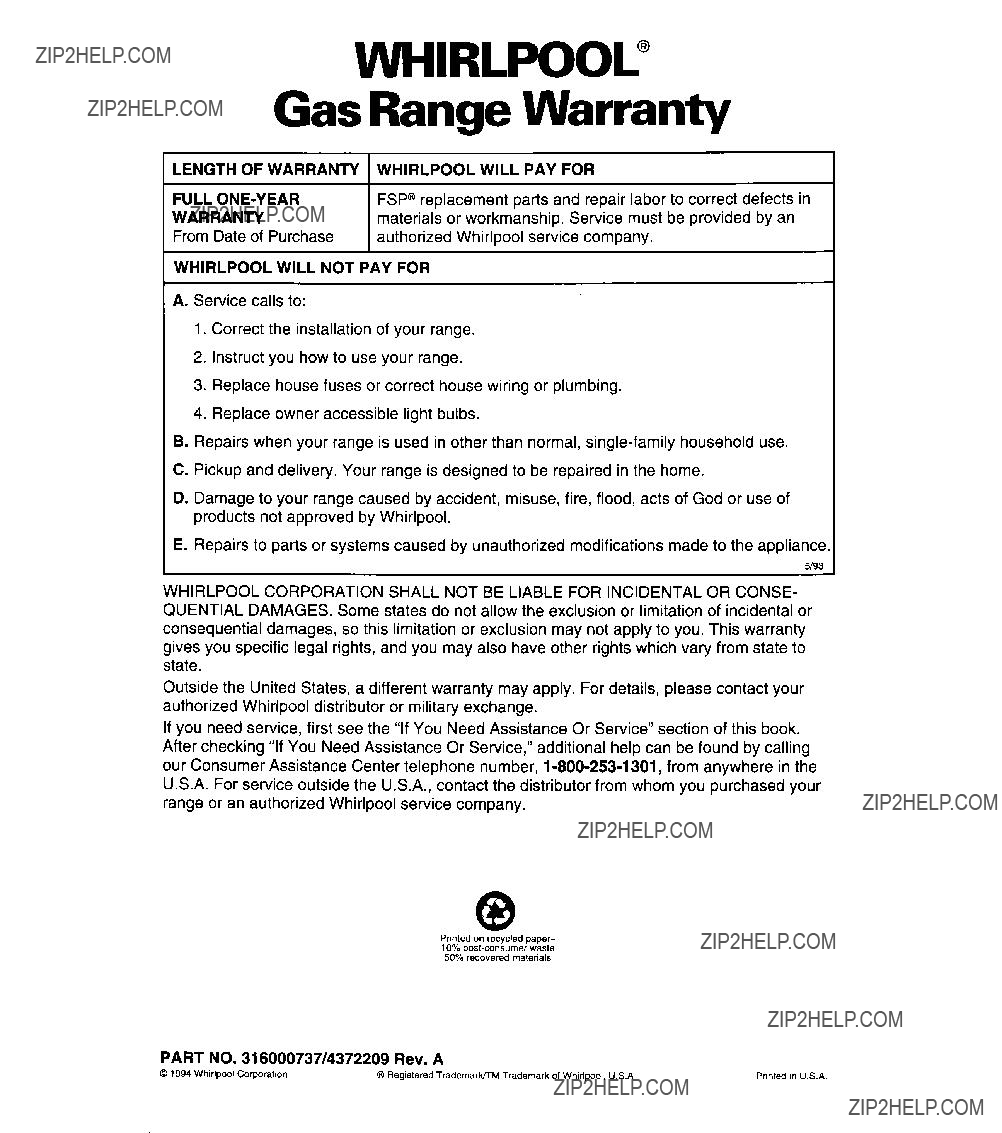
WHIRLPOOL???
Gas Range Warranty
WHIRLPOOL WILL NOT PAY FOR
A.Service calls to:
1. Correct the installation of your range.
2.Instruct you how to use your range.
3.Replace house fuses or correct house wiring or plumbing.
4.Replace owner accessible light bulbs.
B.Repairs when your range is used in other than normal,
C.Pickup and delivery. Your range is designed to be repaired in the home.
D.Damage to your range caused by accident, misuse, fire, flood, acts of God or use of products not approved by Whirlpool.
E.Repairs to parts or systems caused by unauthorized modifications made to the appliance.
5193
WHIRLPOOL CORPORATION SHALL NOT BE LIABLE FOR INCIDENTAL OR CONSE- QUENTIAL DAMAGES. Some states do not allow the exclusion or limitation of incidental or consequential damages, so this limitation or exclusion may not apply to you. This warranty gives you specific legal rights, and you may also have other rights which vary from state to state.
Outside the United States, a different warranty may apply. For details, please contact your authorized Whirlpool distributor or military exchange.
If you need service, first see the ???IfYou Need Assistance Or Service??? section of this book. After checking ???IfYou Need Assistance Or Service,??? additional help can be found by calling our Consumer Assistance Center telephone number,
Printed on recycled paper- 10%
PART NO. 318000737/4372209 Rev. A